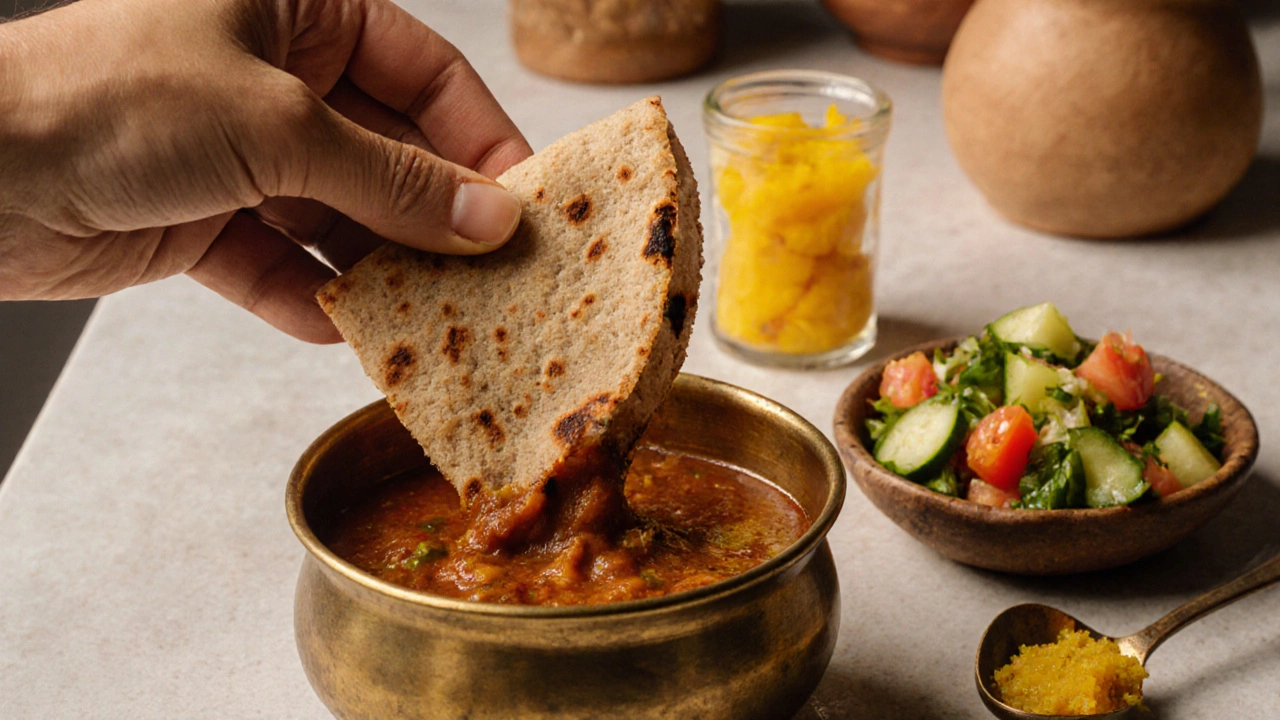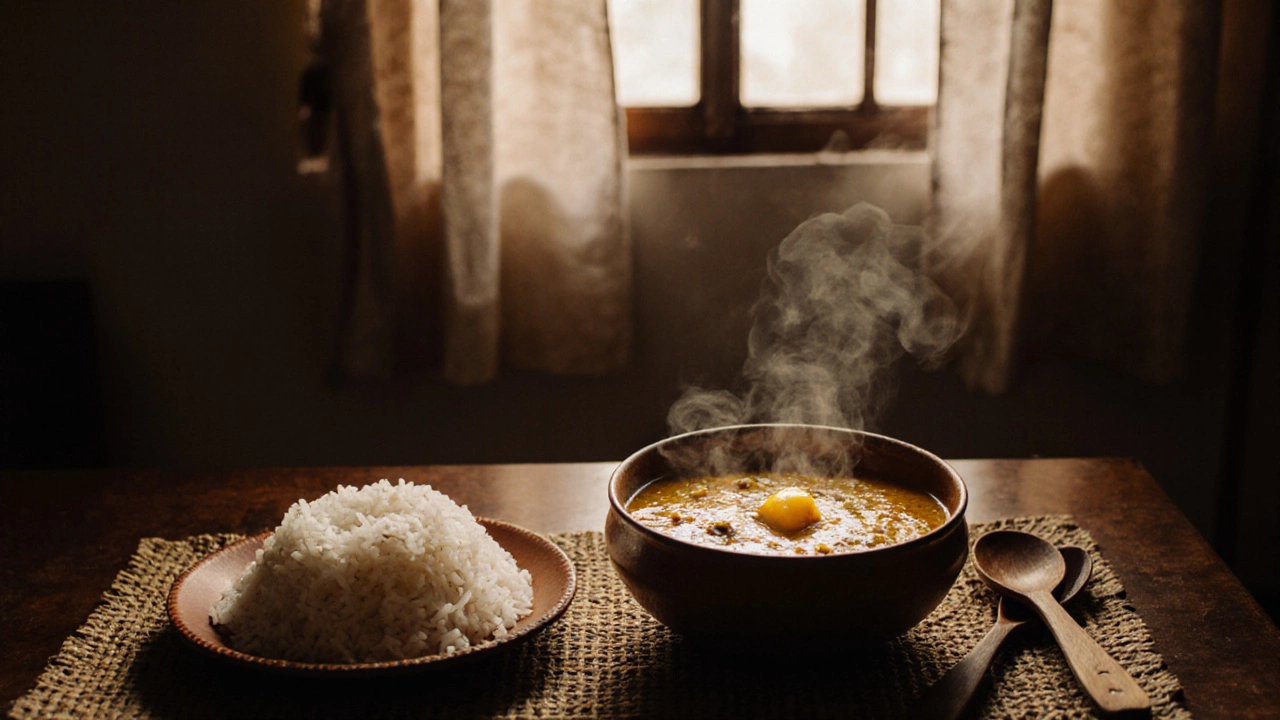There’s a reason dal shows up on nearly every Indian table-whether it’s a quick weeknight dinner or a festive feast. It’s comforting, affordable, and packed with protein. But if you’ve ever stared at a bowl of dal wondering what to serve with it, you’re not alone. The truth is, dal isn’t meant to be eaten alone. It’s the base, the soul, the canvas. And what you pair it with makes all the difference.
Dal and Rice: The Classic Duo
White basmati rice is the most common partner for dal-and for good reason. The mild, fluffy texture of steamed rice balances the earthy richness of lentils. It soaks up the gravy without overpowering it. In homes across India, this combo is called dal-chawal, and it’s eaten daily. Use long-grain rice like basmati for the best texture. Rinse it three times to remove excess starch, then cook with a pinch of salt and a drop of oil. The grains stay separate, not sticky, which lets each bite of dal shine.
For something heartier, try brown rice or red rice. They add fiber and a nutty flavor that pairs well with spiced toor dal or chana dal. One study from the Indian Council of Medical Research found that combining lentils with whole grains improves amino acid absorption-making this pairing not just tasty, but nutritionally smarter.
Roti, Chapati, or Paratha: The Bread That Holds the Soul
If rice isn’t your thing, roti is the next best thing. A warm, soft whole wheat roti is perfect for scooping up dal. Tear off a piece, dip it, and roll it into a little bundle. The slight chewiness of the roti contrasts beautifully with the creamy texture of the lentils.
For a richer experience, go for paratha. Layered with ghee or oil, parathas add a buttery crunch. Try onion paratha with yellow dal, or spinach paratha with masoor dal. The greens in the paratha echo the earthiness of the lentils. In Punjab, people often eat dal with stuffed parathas-aloo paratha, gobhi paratha, even paneer paratha. It’s comfort food at its most satisfying.
Dal and Jeera Rice: A Simple Upgrade
Want to take your dal game up a notch without extra work? Cook your rice with cumin seeds. Heat a teaspoon of ghee in the pot, add half a teaspoon of jeera, let it sizzle for 10 seconds, then add the rice and water. That’s it. The cumin adds a warm, slightly smoky note that lifts the whole dish. It’s a trick used in homes from Delhi to Chennai.
Jeera rice doesn’t compete with the dal-it enhances it. The aroma of toasted cumin mingles with the spices in the dal, creating layers of flavor without needing more salt or chili. Serve it with a dollop of ghee on top. That’s all you need.
Dal and Pickles: The Bold Contrast
Don’t underestimate the power of a spoonful of pickle. A tiny bit of mango pickle, lime pickle, or mixed vegetable pickle can transform a simple dal into something unforgettable. The tangy, spicy, salty punch cuts through the mildness of the lentils and wakes up your taste buds.
In Tamil Nadu, people eat sambar with a side of narthangai (citrus) pickle. In Uttar Pradesh, it’s achar with moong dal. The key is restraint-one small spoonful is enough. Too much and it overpowers. Too little and you miss the magic. Keep a jar of homemade pickle in your fridge. It lasts months and adds instant depth to any lentil dish.

Dal and Raita: The Cooling Companion
Dal can be spicy. Dal can be rich. That’s where raita comes in. A simple yogurt mix with cucumber, roasted cumin, and a pinch of salt cools your mouth between bites. It’s not just a side-it’s a reset button.
Try it with red lentils (masoor dal), which often have a bit of heat from red chilies. Or pair it with urad dal, which can be heavy. The raita lightens the meal. Add finely chopped mint or grated carrot for extra texture. In Bengal, people even mix in a little grated beetroot for color and sweetness. It’s not traditional, but it works.
Dal and Papad: The Crunch Factor
Nothing says Indian meal like the sound of a papad cracking. Thin, crispy, and lightly salted, papads add texture that dal simply can’t provide. Fry them until they puff up, or roast them on the stove. They’re ready in under a minute.
Use plain papad with mild dal, or try spicy pepper papad with lentils that are already richly spiced. The crunch gives you something to bite into after the softness of the lentils. In Maharashtra, people break papad into pieces and stir them into hot dal just before eating. The papad softens slightly, turning into a chewy, flavorful addition.
Dal and Salad: Freshness on the Side
Think salads are only for Western meals? Think again. A simple cucumber-tomato-onion salad with lemon juice and black salt is a perfect counterpoint to dal. It’s light, refreshing, and adds a burst of acidity.
In Gujarat, people serve dal with kachumber-a chopped salad of tomato, onion, cucumber, and green chili. In South India, it’s often called thokku when it’s slightly cooked down. Even in Bristol, where I live, I make this salad with local veggies. It’s quick, it’s healthy, and it stops the meal from feeling too heavy.

Dal and Yogurt: The Simplest Pairing
Yes, plain yogurt. Just a small bowl of thick, chilled dahi on the side. It’s not fancy, but it’s deeply satisfying. The coolness of the yogurt soothes the warmth of the dal. The tang balances the earthiness. In rural India, people eat dal with a spoonful of yogurt right in the same bowl.
Use full-fat yogurt for the best texture. If it’s too thin, strain it through a cloth for an hour. Add a pinch of roasted cumin powder or a sprinkle of chaat masala if you want to elevate it. This pairing is especially good for kids, elderly people, or anyone with a sensitive stomach.
Dal and Khichdi: The Ultimate One-Pot Meal
What if you could combine dal and rice into one dish? That’s khichdi. Made with moong dal and basmati rice, cooked together with turmeric, cumin, and ghee, it’s the ultimate comfort food. It’s easy to digest, gentle on the stomach, and often served during illness or fasting.
Make it simple: rinse 1 cup rice and 1/2 cup moong dal, soak for 30 minutes, then cook with 2.5 cups water, a pinch of turmeric, and a teaspoon of ghee. Add a few whole spices like cumin, black pepper, and bay leaf for aroma. When done, it’s soft, creamy, and golden. Serve with a side of ghee, pickle, or yogurt. It’s dal, rice, and flavor in one bowl.
Dal and Curry Leaves: The Secret Garnish
Don’t forget the finishing touch. A quick tempering of mustard seeds, dried red chilies, and fresh curry leaves in hot ghee poured over hot dal is a game-changer. The aroma alone makes the dish feel more complete.
Curry leaves are not just decoration. They add a citrusy, slightly bitter note that ties all the flavors together. In Karnataka and Kerala, this is standard. Even in London or Bristol, you can find curry leaves in Indian grocery stores. Keep a bunch in the fridge-they last weeks. When you’re done cooking the dal, heat a teaspoon of ghee, toss in 1/2 tsp mustard seeds, then add 8-10 curry leaves. Let them sizzle for 10 seconds, then pour over the dal. That’s it. Instant restaurant-quality flavor.
Can I eat dal with bread other than roti?
Absolutely. While roti is traditional, you can serve dal with naan, pita, or even sourdough. The key is texture-choose something soft enough to scoop but sturdy enough to hold the gravy. Naan works especially well with creamy dal like rajma or chana dal. Just avoid very sweet or dense breads like brioche-they clash with the savory notes.
Is dal healthy on its own?
Dal is packed with plant-based protein, fiber, and iron. One cup of cooked lentils gives you about 18 grams of protein and 15 grams of fiber. But pairing it with rice or whole grains makes the protein complete by adding missing amino acids. It’s one of the most balanced meals you can eat, especially if you skip deep-fried sides and add vegetables or yogurt.
What dal goes best with rice?
Toor dal (arhar dal) and moong dal are the top choices for rice. Toor dal has a hearty, slightly nutty flavor that holds up well with plain rice. Moong dal is milder and creamier-great for kids or when you want something light. Chana dal works too, but it’s denser, so pair it with jeera rice or a side of raita to balance it.
Can I eat dal for breakfast?
Yes, and many people do. In South India, khichdi with dal and ghee is a common breakfast. In the north, people eat moong dal with paratha and pickles. It’s filling, easy to digest, and gives you steady energy. Skip heavy spices if you’re eating it early-keep it mild with just cumin and turmeric.
How do I store leftover dal and sides?
Store dal in an airtight container in the fridge for up to 4 days. Reheat with a splash of water to restore the texture. Rice keeps for 3 days. Roti or paratha should be stacked with parchment paper in between and reheated on a dry pan. Pickles, raita, and papads can be stored separately-pickles last months, raita lasts 2 days, and papads stay crisp in a sealed jar.
